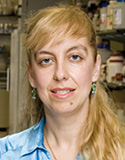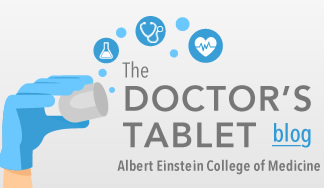Targeting HIV with Radiommunotherapy
Radioimmunotherapy Could Potentially Eradicate Lingering HIV Infection
December 3, 2013 – (BRONX, NY) – Nearly nine million adults worldwide living with the human immunodeficiency virus (HIV) receive antiretroviral therapy. Although highly active antiretroviral therapy (HAART) keeps the virus from multiplying by killing the virus in the bloodstream, it does not cure patients infected with HIV because it does not completely eliminate the HIV-infected cells in which the virus can replicate.

Ekaterina Dadachova, Ph.D.New findings presented today at the annual meeting of the Radiological Society of North America (RSNA) by researchers at Albert Einstein College of Medicine of Yeshiva University show that radioimmunotherapy (RIT) could potentially eradicate HIV-infected cells.
"There have been major strides in HIV treatment that slow disease progression, but we’re still searching for a permanent cure," said study leader Ekaterina Dadachova, Ph.D., professor of radiology and of microbiology & immunology. "To combat HIV, we need a method that will completely eliminate all HIV-infected cells without damaging non-infected cells."
In RIT, historically known as a cancer treatment, radioactive isotopes attached to antibodies selectively target and destroy cells. After the antibodies deliver the radioisotope to a specific target, such as a cancer cell or disease-causing microbe, the radioisotope delivers a lethal dose of radiation without harming healthy cells.
The research presented at RSNA builds off earlier work by Dr. Dadachova showing RIT could successfully target and destroy human immune cells infected with HIV. Now, Dr. Dadachova in collaboration with her colleagues Arturo Casadevall, M.D., Ph.D. and Barry Zingman, M.D., administered RIT to blood samples from 15 HIV patients treated with HAART at The AIDS Center at Montefiore, the University Hospital and academic medical center for Einstein. They found that RIT was able to specifically kill HAART-treated lymphocytes and reduce HIV infection to undetectable levels in the majority of samples. This research was conducted on ex vivo human blood samples from HIV-positive patients, not the patients themselves.
"We found that radioimmunotherapy could kill HIV-infected cells both in blood samples that received antiretroviral treatment and within the central nervous system, demonstrating RIT offers real potential for being developed into an HIV cure."
-- Ekaterina Dadachova, Ph.D.
The Einstein researchers also investigated whether the RIT approach can reach HIV-infected cells in the brain and central nervous system. Current anti-retroviral therapy drugs do not efficiently penetrate the blood-brain barrier, a system of blood vessels that stops harmful substances from crossing into the brain. This is why many HIV patients treated with HAART often suffer from severe cognitive impairment. Using a laboratory model of the blood-brain barrier constructed of human cells and developed by Joan Berman, Ph.D., they showed that the same radiolabeled antibodies used in earlier experiments could eliminate HIV-infected cells in the brain without damaging the barrier.
"We found that radioimmunotherapy could kill HIV-infected cells both in blood samples that received antiretroviral treatment and within the central nervous system, demonstrating RIT offers real potential for being developed into an HIV cure," said Dr. Dadachova, who also holds the Sylvia and Robert S. Olnick Faculty Scholar in Cancer Research.
This research is currently in the pre-clinical stage. The goal is to test the radioimmunotherapy in clinical trials. At this time the trials are being explored. No date has been set for trials to begin.
Dr. Zingman is professor of clinical medicine at Einstein and medical director of The AIDS Center at Montefiore. Dr. Casadevall is professor and chair of microbiology & immunology at Einstein and attending physician, medicine at Montefiore. Dr. Berman is professor of pathology and of microbiology & immunology at Einstein.
The experimental work was carried out by Alicia McFarren, M.D., a pediatric oncology fellow, and Dina Tsukrov, M.S., a graduate student. The team used a radionuclide supplied by the collaborators at the Institute for Transuranium Elements (ITU), Karlsruhe, Germany.
Other Top Stories
9/11 World Trade Center Exposure Linked to Heart Disease Among NYC Firefighters
On Becoming a Physician: New Einstein Students Receive White Coats and Stethoscopes
Novel Therapy for Acute Migraine Shows Promise in Phase 3 Clinical Trial
First Complete Wiring Diagram of an Animal's Nervous System
Multimillion Dollar NIH Grant to Help Reduce Opioid Use & Get Care to People Who Need It
NIH Grant Funds $23 Million Study of Diseases Affecting People Living with HIV
New TAILORx Data Guides Adjuvant Therapy in Younger Breast Cancer Patients
Einstein Celebrates Its 61st Commencement
Bolstering Biopsies: Testing Patients' Individual Cells to Guide Treatment



Tablet Blog